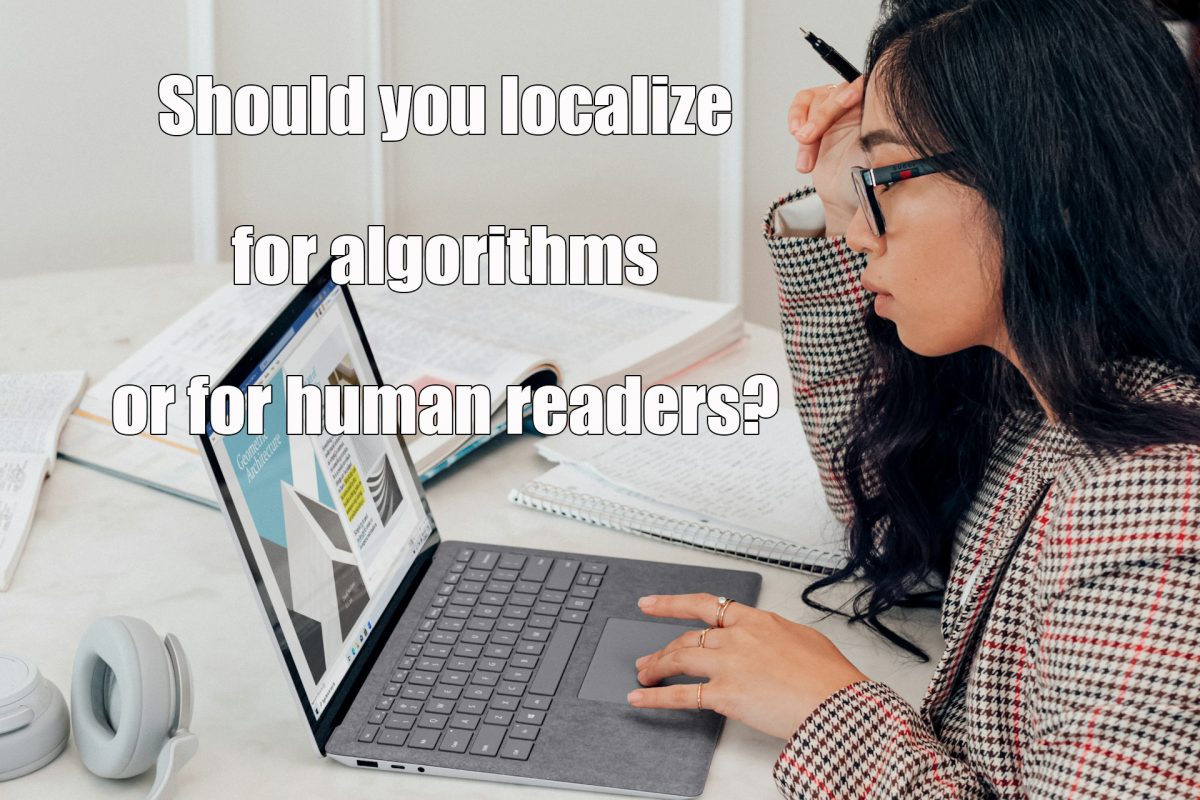
Whether the content you’re writing or getting localized should be focusing more on the human reader or a search engine’s algorithm depends on many factors. Of course, material on paper doesn’t need to cater to an algorithm, but it will still be advantageous to maintain the same terminology, keywords, and maybe even the tone, across various media and platforms. On the flip side, focus too much on the algorithm and you may wind up with content that won’t be appealing, persuasive or engaging for a human audience. Read on for some tips on how to handle this conundrum.
For Your Online Content
Online content, such as your website, should cater to both human readers and search engine algorithms, but with a focus on the human experience. Long gone are the days of keyword stuffing; today a complex strategy focused on providing value to users is necessary.
Your main content, including informative text, product descriptions, and calls to action, should be clear, concise, informative, and written in a tone that resonates with your target audience. Use headings and subheadings to break up the text and make it easy for users to scan and find the information they need. Menus and navigation bars should be intuitive and user-friendly, allowing visitors to find what they’re looking for quickly.
The same rules apply when localizing your website into another language, so, fundamentally, a good website in your home language should set the foundation for a good localized site. But keep in mind some potential challenges here. Headings and subheadings may wind up way longer (or shorter) than the original depending on the language pair you’re dealing with. You may need to go beyond translation to find the most appropriate way to address this disparity. This is especially crucial in places where character limits exist. Also, the so-called “casual” or “friendly” tone that may resonate in your home market may not work in your target market, such as in Japan, where that same tone would come across as unnatural, unserious, and disrespectful.
The best content in the world may go unnoticed if SEO (Search Engine Optimization) is ignored. So this is where you’ll need to make sure your online content is equipped with title tags and meta descriptions (those short snippets of text that appear in search results). Optimize them with relevant keywords to help search engines understand your content and rank it for those terms. And when localizing those keywords into other languages, it’s important that you don’t just translate them into the target language. Researching the target market and understanding the proper keywords there is crucial in getting your content noticed by both search engine algorithms and human readers. For example, in Japan the term “Boba tea”(ボバティ) would not be nearly as visible as タピオカ (tapioca), and “Social media” (ソーシャルメディア) is virtually unknown as people there call it SNS (short for “social networking service”).
Images, videos, and infographics enhance the user experience and make the content more visually appealing, which is undoubtedly a plus for the human reader. But be sure they’re accompanied by appropriate alt texts that briefly describe the item using relevant keywords. In addition to improving accessibility for visually impaired users, these alt texts play an important role in helping search engines understand what the graphic is about. A not-so-thoroughly applied localization job can be instantly spotted if the alt text displays in a language that’s different from the language on the site.
Relevant keywords should also appear within your headings (especially the main H1 heading) and meta descriptions. These short snippets are crucial for search engines to understand your content and should be crafted with the right keywords as they are more relevant to addressing the algorithm than the human reader. But organizing your content logically with a clear hierarchy of headings and subheadings will help both the search engine and human visitor understand your site better.
Getting back to the main content of your website, it’s also important to be aware that some types of content perform better with a heavier SEO presence than others. Narrative content (such as stories, creative writing pieces and personal experiences) and some types of informative content (such as explainers and “listicles”) will not keep visitors on your page for long if not written primarily with the human reader in mind. But SEO becomes much more of an issue with your product descriptions, service explanations, and “About Us” sections, which should be clear and informative for humans but also incorporate relevant keywords to encourage search engine traffic. And blog posts are especially effective since they can be written to target specific keywords while offering valuable information to readers.
For Printed Material and Other Offline Content
Of course, a printed pamphlet or brochure would not require SEO best practices in and of itself, but remember if there is any chance of its text going online as a web page or downloadable PDF file, it might be in your best interests to adopt some of the SEO-relevant writing techniques mentioned earlier.
But for the sake of argument, let’s say your printed material will not be destined for the internet at all. Although SEO will play no part in this equation, you might want to consider consistency. Inconsistent messaging or terminology across digital and analog media may not reflect well on your service or brand. And although it may be easy enough to maintain consistency within your home language (which you can read), what happens when your digital and paper content gets localized into other languages, perhaps by different vendors?
For example, it’s not uncommon for a website and a brochure to be localized by different vendors because the two jobs would be separate projects and may be handled by different departments within the client’s company. The challenge in this case scenario would be in maintaining consistent terminology and tone across media types in the target language. Of course, discrepancies within the digital domain will likely impact your search engine discoverability in a negative way, and customers may shy away from your products or services if your website says one thing and your brochure says another. Such potential nightmares can be avoided by either using the same language service provider across different media, or building a glossary or termbase to help maintain uniform terminology and keywords across different providers. Do this for all languages you are dealing with.
Long Story Short
Circling back to the main premise of this blog post, should your content be written and localized for a human reader or an algorithm? Well, there actually isn’t a strict divide between content for humans and algorithms, as all content should ultimately be written with humans in mind, although some types lend themselves more naturally to SEO than others. In fact, it is said that old-school “keyword stuffing” will cause the algorithm to penalize your search rank. The best content combines human-centric writing with strategic use of relevant keywords.
All in all, your top priority should be on creating high-quality content that is valuable and informative for your target audience and maintains consistency after localization. Since search engines are getting better at understanding human language, well-written content should naturally incorporate elements that both humans and algorithms appreciate. Strive for the win-win, for human and machine alike.
Douglass McGowan






